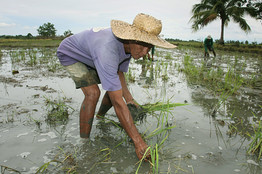May 20, 2014 – According to a 35-year study by the International Rice Research Institute (IRRI), a non-profit, independent research and training organization, there is a clear trend evident in nighttime temperatures. They have been steadily creeping up and today are 1 Celsius (1.8 Fahrenheit) degree higher over the period of time.
IRRI manages the longest-running rice research project on the planet and note that higher night time temperatures tend to suppress rice yields. According to Grace Centeno, a scientist at IRRI, “Average night temperature over 23 degrees Celsius can lead to yield loss due to the increased need of the rice plant to expend its energy to maintain its biological health.”
In a previous release of the study showing data from 1979 to 2003, rice yields declined by 10% for every Celsius degree increase in nighttime temperatures. Since then the study has continued and negative impact on crop yields is becoming more pronounced. The critical threshold for rice appears to be 23 Celsius (73 Fahrenheit). At these temperatures rice grains have trouble forming properly. Hence reduced yields. A 1% increase in temperature translates to a 6% yield decline.
At 10% yield reductions amount to 0.5 tons of rice per hectare (2.47 acres). In countries where rice is the principle food staple and where population growth appears to be greatest on our planet today, declines of this magnitude can mean the difference between a fed population and famine.
Without remediating climate change all that agriculturists can do is find new varieties of rice that can tolerate these increased nighttime temperatures. And if they cannot then in many countries such as The Philippines and others in South and East Asia, declining yields could play havoc with national stability.
The Case of The Philippines
Today in The Philippines where the IRRI study was done rice is grown on small family farms (like the one in the picture above) that average in size from 0.5 to 4.0 hectares. These are largely subsistence operations with small surpluses. There is no new land for farming and with high population growth demand continues to rise.
In 2006 the country produced 11.2 million metric tons of rice with yield growth at that time fairly flat. Once upon a time the country was self-sufficient in rice. But in 2006 it only grew enough to feed 90% of its population which meant the country had to import rice from other Southeast Asian countries producing surpluses. Since then the gap has widened.
Now as rice yields continue to be flat or in decline by as much as 10% based on the study, The Philippines will need to import even more of its major food staple. But from where? If other neighboring countries are also experiencing yield declines who will provide the rice to feed the country?
In 2006 daily rice consumption amounted to 33,000 tons and accounted for 20% of the cost of food per household. Scarcity will only mean higher prices and a greater percentage of the household food budget. Imported rice will certainly cost more as well. Rice is the main staple food for these people as it is for so many other countries in South and East Asia. And what happens when their yields are affected by the same problem, rising nighttime temperatures?
And none of this takes into consideration extreme weather events like the recent Typhoon Haiyan with its devastating impact on the rice crop. In the picture below you can see farmers replanting rice in fields where the typhoon inflicted significant damage.
All in all the situation in The Philippines is not a pretty picture. One solution for the nation is to alter the eating habits of its people moving them from rice as the major staple to another crop. Such a change would be difficult to institute. The most likely outcome at the minimum would be social unrest. The much more threatening scenario is famine.


















Excellent article. It is very concerning how little night time temperature change can so adversely affect rice yields. For many countries, some of which I have first hand knowledge, rice is such a key nutritional and financial crop. Perhaps one of the negative effects will be the dropping off of children’s education, so often dependant upon a family having a small surplus of cash. We are facing very troubling times ahead.
Hi Simon, I think that falling rice yields because of rising nighttime temperatures is the tip of the iceberg. One of my readers on LinkedIn pointed out that wheat is similarly affected. My guess is corn or maize, the other great annual food staple is as likely to be impacted as well. We can scramble to create new crop strains that can beat the heat or we have to find other food sources to provide adequate nutritional replacement to cover the delta in yield rates. You can imagine just how destabilizing declining crop yields can be on countries that today are struggling to feed their populations. These are the most vulnerable people and political instability at best will be the end result. At the worst we will see famine and climate change induced mass migration putting pressure on neighboring countries that are not as afflicted. I hate Doomsday Scenarios but adapting to climate change and mitigating the worst impacts of increased carbon in the atmosphere and oceans requires immediate action so that we have the tools in place to lessen the blow.